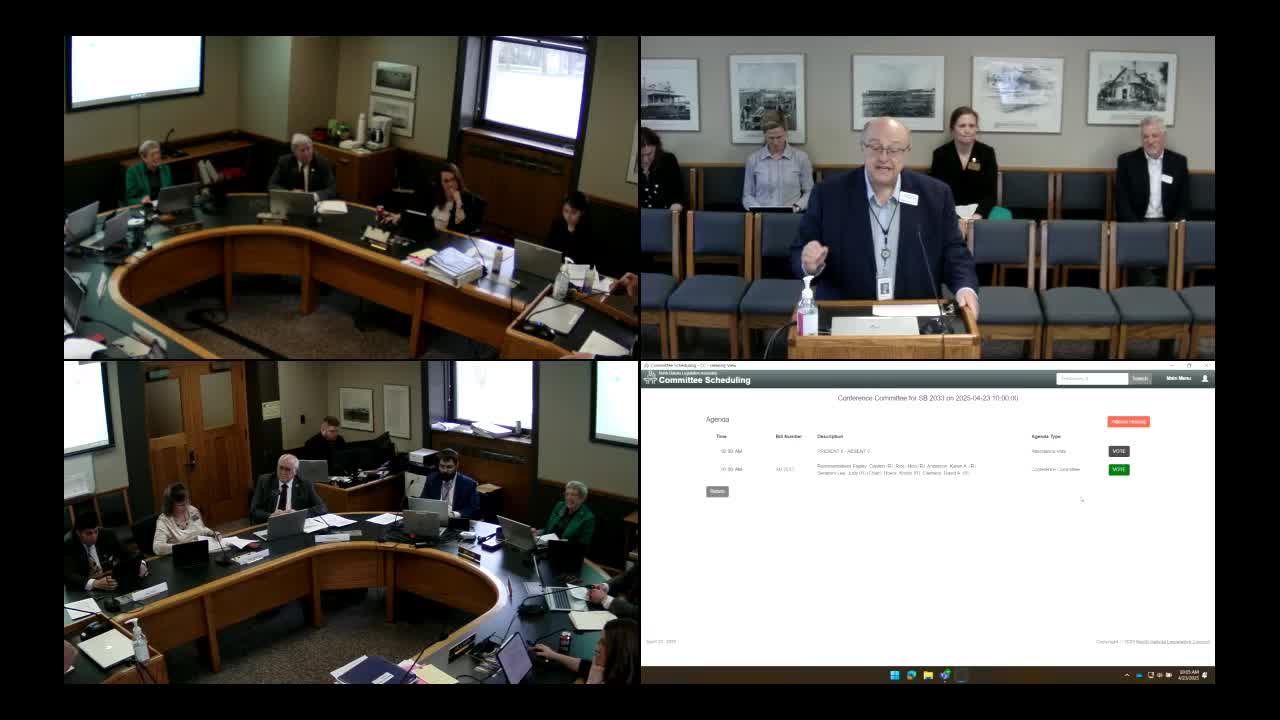Emergency Medical Services discuss worsening staffing issues in rural ambulance services
April 23, 2025 | Senate, Legislative, North Dakota
This article was created by AI summarizing key points discussed. AI makes mistakes, so for full details and context, please refer to the video of the full meeting. Please report any errors so we can fix them. Report an error »

The SB 2033 Conference Committee meeting held on April 23, 2025, focused on critical issues surrounding the staffing and operational challenges faced by ambulance services in North Dakota. The discussions highlighted the ongoing staffing shortages and the implications for emergency response capabilities across rural communities.
The meeting began with Chris Weidrick, the unit lead, addressing the chronic staffing issues that many ambulance services are experiencing. He emphasized that while occasional staffing problems may arise, the real concern lies in the persistent inability to maintain a full roster of responders. This chronic condition is a significant indicator of potential regulatory action, although Weidrick noted that a single instance of failure to respond does not automatically trigger such measures.
Committee members raised questions about how the state monitors ambulance service schedules and response times. Weidrick explained that while ambulance run reports are mandatory, they often come too late to address immediate staffing concerns. The committee discussed the need for a more reliable data mechanism, particularly involving 911 operators, who may hesitate to report failures to respond due to concerns about repercussions.
Senator Clements pointed out the responsibility of local communities to ensure their ambulance services are adequately staffed. Weidrick acknowledged this but highlighted the challenges communities face when they struggle to recruit volunteers. He noted a decline in volunteerism over the years, complicating the sustainability of these services. The conversation underscored the importance of not only having a transportation system but also ensuring effective medical interventions are available during emergencies.
Representative Feigley brought attention to the issue of daytime coverage in rural areas, where many residents commute to larger cities for work, leaving gaps in ambulance availability. This concern was echoed by other committee members, who recognized the need for solutions to enhance staffing during peak hours.
The meeting concluded with a consensus on the urgency of addressing these staffing challenges to ensure that rural ambulance services can meet the needs of their communities effectively. The committee plans to continue exploring potential strategies to improve workforce sustainability and response capabilities in the coming sessions.
The meeting began with Chris Weidrick, the unit lead, addressing the chronic staffing issues that many ambulance services are experiencing. He emphasized that while occasional staffing problems may arise, the real concern lies in the persistent inability to maintain a full roster of responders. This chronic condition is a significant indicator of potential regulatory action, although Weidrick noted that a single instance of failure to respond does not automatically trigger such measures.
Committee members raised questions about how the state monitors ambulance service schedules and response times. Weidrick explained that while ambulance run reports are mandatory, they often come too late to address immediate staffing concerns. The committee discussed the need for a more reliable data mechanism, particularly involving 911 operators, who may hesitate to report failures to respond due to concerns about repercussions.
Senator Clements pointed out the responsibility of local communities to ensure their ambulance services are adequately staffed. Weidrick acknowledged this but highlighted the challenges communities face when they struggle to recruit volunteers. He noted a decline in volunteerism over the years, complicating the sustainability of these services. The conversation underscored the importance of not only having a transportation system but also ensuring effective medical interventions are available during emergencies.
Representative Feigley brought attention to the issue of daytime coverage in rural areas, where many residents commute to larger cities for work, leaving gaps in ambulance availability. This concern was echoed by other committee members, who recognized the need for solutions to enhance staffing during peak hours.
The meeting concluded with a consensus on the urgency of addressing these staffing challenges to ensure that rural ambulance services can meet the needs of their communities effectively. The committee plans to continue exploring potential strategies to improve workforce sustainability and response capabilities in the coming sessions.
View full meeting
This article is based on a recent meeting—watch the full video and explore the complete transcript for deeper insights into the discussion.
View full meeting
